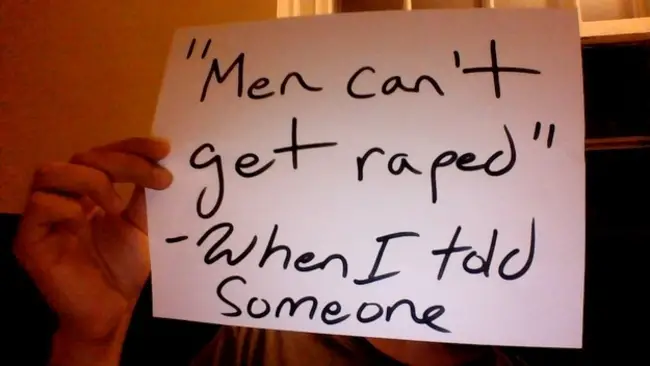According to the Rape, Abuse & Incest National Network (RAINN), 11.2 percent of all college students, including undergraduates and graduates, experience “rape or sexual assault through force, violence, and incapacitation.” Only one out of five female victims in college report their sexual assault to law enforcement. And of the male college victims? RAINN doesn’t mention it. This exclusion could mean one of two things: Either RAINN, a respected institution, tried to get the data, but so few raped men came forward to warrant statistical inclusion; or, it didn’t try to get the data at all.
Regardless, both cases imply that male rapes are so stigmatized and misunderstood that either raped college men are unwilling to come forward, or that RAINN doesn’t see a worthy duty in soliciting those men for thorough research. Both cases, in other words, point to a grander theme—an intense societal stigma and ignorance of male rape victims.

Undoubtedly, rape has always been a gendered issue, with feminism playing a large role in bringing the issue of rape into a new public light. For almost forty years, partly in thanks to Susan Brownmiller and her seminal 1975 book “Against Our Will,” the word “rape” no longer connotes a lust-based sexual act, but one that is criminally violent and power-centric.
And, as radical feminism began to bud from its more liberal parentage, it helped raise awareness that the violence inherent in rape was not just an issue in and of itself, but rather something that existed within a societal construct traditionally scarred by a deep prejudice against women. But the mission of radical feminism, though laudable, had an unfortunate consequence. It helped further to cement the age-old idea that rape is an only female problem.
In fact, the definition of the word “rape” has a history skewed against men. Since the 1930s, the FBI defined rape as “the carnal knowledge of a female forcibly and against her will.” This definition explicitly restricted rapes to apply to only females, and, for a long time, local governments excluded male rapes when reporting to the FBI.
For example, in 2010, Chicago, recorded 86,767 cases of rape, but used a broader definition of rape, so the FBI left out Chicago’s statistics. Localities began to complain, and, in 2012, the FBI finally changed its outdated definition of rape to “the penetration, no matter how slight, of the vagina or anus with any body part or object, or oral penetration by a sex organ of another person, without the consent of the victim.” Only recently did the FBI officially lift “rape” as a term exclusive to women.
The FBI had excluded data that didn’t fit its already-prejudiced view of rape, and thus misrepresented its statistics on rape in general. But the danger of holding such preconceived notions goes deeper; it hides the actual truth about the prevalence of male rape.
In their lucid 2014 study, Lara Stemple and Ilan Meyer looked into five federal surveys from the FBI, the Bureau of Justice and the Centers for Disease Control and Prevention (CDC). They found that the CDC, in its 2010 survey, reported that 1,270,000 women were raped, and presented its findings that suggested women are disproportionately affected by sexual violence. But the CDC put male’s nonconsensual sex (“being made to penetrate”) in a separate category marked as “Other sexual violence.” When taking this into account, the number of raped women and of men forced to penetrate are nearly equal: 1,270,000 and 1,267,000, respectively.
If feminism is truly about the equality of both sexes, and not the mere promotion of one, then its followers should realize that the violence and power inherent in rape can victimize both men and women. But claiming a cause for equality, while framing certain issues as purely feminine, like rape and sexual assault, has the same effect as claiming a cause for only women; both don’t recognize the possibility that a prejudice against men, not just of women, could also be tipping the balance.
As Joss Truitt from “Feministing” points out, sexual violence doesn’t fit the standard narrative of feminism, and challenges the habit of forming two boxes—men who represent power and women who are the oppressed—that make it harder for other survivors, including men, trans women, genderqueer and other gender non-conforming, to fit in.
College campuses, where the cowardly “rape culture” is most invasive, need feminists to stand up for both female and male rapes. By remembering the male victims, college feminists can send a powerful message to today’s youth that rape is, and has always been, a violent and power-centric act that is indiscriminate of gender, and that they aim to fight not against a particular masculine hegemony, but truly for the equality of both sexes.


















[…] Recent studies seem to point to higher rates of male rape than what had been assumed because society presumes males (even in their teens) should have the capability to defend themselves in any and all situations when attacked. So it wasn’t until recently that male victims of rape (including both female-on-male and male-on-male situations) were counted in crime statistics after they objected to how they were categorized, at least in the US. […]
[…] Source: Male Rape May Be More Common Than Previously Thought […]
[…] Yorker, “The Silence: The Legacy of Childhood Trauma,” explores childhood trauma, rape and suicidal ideation, so proceed with caution if you choose to read […]